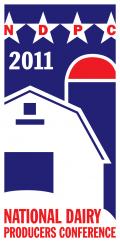CWT Getting Closer to Achieving 75% Membership Goal for 2011
January 05, 2011The CWT Export Assistance program provided assistance in February to four CWT member cooperatives selling 11.2 million pounds of Cheddar and Monterey Jack cheese to 10 countries on four continents. The product is scheduled to be shipped from March through June 2011. Add to that the 22.7 million pounds of CWT-assisted 2010 cheese sales scheduled to be shipped in the first six months of 2011, and the Export Assistance program will be making a significant contribution to expanding overseas sales.
The 52 million pounds of cheese exports assisted by CWT and shipped in 2010 account for 13.6% of total U.S. cheese shipments. The 17 million pounds of butterfat (in the form of butter and anhydrous milk fat) CWT assisted and shipped in 2010 equaled 14.1% of total butterfat exports. These CWT sales produced an additional $398 million of revenue, adding an average of 18 cents per hundredweight to U.S. producers’ milk checks in 2010.
Some producers have questioned why CWT provides export assistance when the cheese price is $2.00 a pound. The purpose of CWT is to help maintain the role of the U.S. as a consistent, reliable exporter of value-added dairy products, which is not a role that American suppliers have played historically. In the past, the tendency of U.S. manufacturers was to export only what the domestic market would not absorb. By 2008, the export arena became a major buyer of U.S. milk solids, with total sales of 11%.
In 2009, a combination of factors resulted in U.S. dairy product exports dropping 15.5%, the equivalent of 1.7% of total U.S. milk solids produced. However, it was in products that most impact producer milk prices where the biggest drops occurred – cheese exports down 50 million pounds, butter exports down 126 million pounds, and skim milk powder (protein standardized nonfat powder) down 314 million pounds.
In order to prevent a re-occurrence of 2009 in the coming year, CWT must continue to assist U.S. cheese sales in the world marketplace. When the participation in CWT reaches the 75% level necessary for the 2¢ assessment to begin, CWT will be able to add to the products receiving export assistance and maintain U.S. dairy producers’ world market share and reasonable margins.
Dairy Industry Gears Up for 2011 National Dairy Producers Conference
January 05, 2011Dairy producers from around the country will pack their bags and head to Omaha, Nebraska for the May 15-17, 2011 National Dairy Producers Conference (NDPC). Formerly known as the National Dairy Leaders Conference, the NDPC will provide an in-depth discussion of the issues facing the dairy industry, with educational discussions on many of the key challenges looming in 2011.
“The NDPC gives dairy producer participants the opportunity to listen, learn, and lead,” said Jerry Kozak, President & CEO of the National Milk Producers Federation, which is organizing the conference. “It’s a way to critically analyze the status of the dairy industry now and discuss possible solutions for the future.”
The NDPC will include a farm policy outlook panel that will look at the development of the next Farm Bill and feature congressional staff, other national farm organizations, agricultural lenders, and dairy producers as speakers. A trade policy panel will address technical barriers for global dairy trade and market access and include a speaker from the U.S. Dairy Export Council, among others.
Another NDPC session will cover the dairy industry’s environmental concerns, such as carbon regulation, EPA’s Total Maximum Daily Load regulation, results from the National Air Emissions Monitoring Study, and the outlook for EPA’s Spill Prevention, Control, and Countermeasure program. Animal care challenges remains a concern for many dairy producers, and the NDPC will include a session that will feature speakers from major retailers and processors who will explain their expectations of animal care from farmers. Another NDPC session will address costs of production (such as energy and feed), and will focus specifically on managing change and risk.
The NDPC sessions will be preceded by optional farm tours that will take place on Sunday, May 15. Participants will be able to tour local dairy farms and visit a nearby ethanol production plant.
Although the conference is geared primarily toward dairy producers, anyone with a stake in the dairy industry is invited to attend. This may include dairy cooperative executives and directors, dairy processors, suppliers and consultants to the dairy business, state and federal regulators, promotion organization executives, and academics.
More information on the NDPC will be posted online at www.nmpf.org/NDPC when it becomes available.
Dairy Groups Urge Immediate Passage of U.S.-South Korea Trade Agreement
January 05, 2011In early December, the National Milk Producers Federation (NMPF) and the U.S. Dairy Export Council (USDEC) applauded the successful negotiations between the U.S. and South Korea aimed at resolving areas that had prevented advancement of the U.S.-Korea Free Trade Agreement.
The White House announced that the agreement had been finalized, after much hard work during the past several months to resolve issues maximizing the prospects of getting the FTA approved by Congress.
“This FTA will be the most significant for the dairy industry since the agreement with Mexico as part of NAFTA, and it will provide major benefits for U.S. dairy producers” said Jerry Kozak, President and CEO of NMPF. “By opening up a major dairy market to our products, this FTA will deliver, on average, an additional $380 million a year in benefits to U.S. dairy producers during the phase-in period of the agreement.”
Both organizations urged the Administration to send the U.S.-South Korea FTA to Congress for immediate action. NMPF and USDEC also reiterated their support for the U.S. FTAs with Colombia and Panama. The U.S. dairy industry hopes to ultimately see congressional approval of all three pending FTAs, as all would yield meaningful new opportunities for U.S. dairy exports and net benefits for the U.S. dairy industry.
EPA Begins Regulating Greenhouse Gases
January 05, 2011In January 2011, the Environmental Protection Agency (EPA) officially started regulating greenhouse gas (GHG) emissions under the Clean Air Act (CAA). Industries that are the largest emitters of GHGs will be required to obtain CAA permits and implement cost-effective technologies and energy efficiency measures. EPA will exempt smaller sources from permitting requirements, which includes farms and ranches. However, the agency is set to reevaluate the permitting threshold in 2016. If the level is reduced to the CAA statute of 250 tons per year of GHGs, nearly 99% of U.S. dairy farms could be regulated.
Nevertheless, EPA officials could soon see their hands tied if several members of Congress are successful with efforts. With their attempts to halt the GHG regulations proving futile in the 111th Congress, several key leaders in the House of Representatives and the Senate expect to generate support once again, and this time they expect more members to join them. While it will be extremely difficult to overturn the rule that provides EPA the authority to regulate GHGs, Congress may look to defund the agency’s efforts for the foreseeable future. Without question, oversight of the EPA will be a major priority for many in the 112th Congress.
Pollution Diet Set for Chesapeake Bay
January 05, 2011Before the close of 2010, the Environmental Protection Agency (EPA) released its final plans for cleaning up the Chesapeake Bay. Known as a total maximum daily load (TMDL), EPA set a “pollution diet” for the Chesapeake Bay Watershed, a 64,000-square-mile region covering Delaware, Maryland, New York, Pennsylvania, Virginia, West Virginia, and the District of Columbia.
The plan requires the six Bay states and D.C. to implement plans that will lead to a reduction in the flow of certain nutrients – nitrogen, phosphorus, and sediment – into the Bay by 20 to 25 percent by 2025, with 60 percent of that goal to be met by 2017. In order to meet these goals, each jurisdiction must chart out a course of how they will meet the reductions prescribed by the EPA. After being rejected initially, these plans were ultimately approved by the EPA, with the exception of a few sectors.
In order to aid farmers in meeting these rigorous goals, several of these plans provide additional funding for agricultural programs, and new assistance for the development and implementation of manure-to-energy projects. Unfortunately, there are serious concerns with many aspects of these final plans, including a potential scenario where farmers may be faced with mandatory programs if goals aren’t realized, which could come as soon as 2013. There were a few instances where the EPA did not approve aspects of a submitted plan. In one instance, EPA crafted a targeted backstop for the agriculture sector in West Virginia. The federal agency also plans to apply additional oversight on Pennsylvania farmers.
CWT Settles Lawsuit over Disposition of Cattle in Herd Retirement Program
January 05, 2011Cooperatives Working Together (CWT) announced before the holidays that it had successfully reached an out-of-court settlement with the defendants in the civil action entitled Kessler v. Greenville Livestock, Inc., which was filed in the Circuit Court for St. Clair County, Illinois on September 1, 2010.
The National Milk Producers Federation (NMPF), which manages CWT, had joined with Illinois dairy farmer Kevin Kessler, and Kessler Dairy Inc., as a plaintiff in the action. The dispute involved transactions related to CWT’s herd retirement program.
By agreement with defendants, the terms of the settlement will not be disclosed. However, all parties are satisfied that the settlement resolves the case fairly. Jerry Kozak, NMPF President and CEO, said: “We have always fully investigated every report involving allegations about the proper operation of Cooperatives Working Together, and we felt, in this situation, that we needed to take legal action. The settlement agreement we have made with the defendants preserves the integrity of the CWT program and protects dairy farmers’ investment in CWT.”
111th Congress Comes to a Close; New Congress Begins This Week
January 05, 2011The final month of the 111th Congress witnessed a flurry of last-minute activity, which included estate tax reform, a major reauthorization of the school lunch program, and landmark food safety legislation. As part of the Tax Relief, Unemployment Insurance Reauthorization and Job Creation Act of 2010, Congress set the estate tax exemption level at $5 million ($10 million for couples), and the rate at 35 percent.
This development is vital for many of the nation’s farmers and ranchers, as the exemption level and rate were to reset at $1 million and 55 percent, respectively, in 2011. Congress also successfully passed a major child nutrition law to increase funding for the school lunch program and allow for nutritional standards to be set for all foods sold in schools, while also clearly recognizing the vital importance of milk consumption for our nation’s youth. Furthermore, Congress sent the FDA Food Safety Modernization Act to the President’s desk, marking the first significant reform since 1938 of the Food and Drug Administration’s oversight of the food supply. President Obama signed it Tuesday.
There were also a few key issues that were not tackled before the 111th Congress concluded. Even though there was a late push by the Administration and several key Congressional leaders, immigration reform was stopped short by procedural hurdles. Legislation to repeal 1099 tax provisions also fell a few votes short, leaving many farmers and ranchers vulnerable to new, burdensome tax filing requirements.
On Wednesday this week, Ohio Congressman John Boehner was sworn in at the new Speaker of the House, signaling the start of the 112th legislative session. NMPF will continue its efforts in the coming months to work with leaders in both parties to implement new dairy policy.









